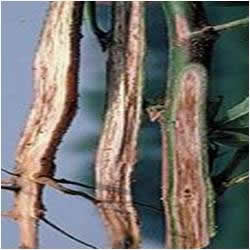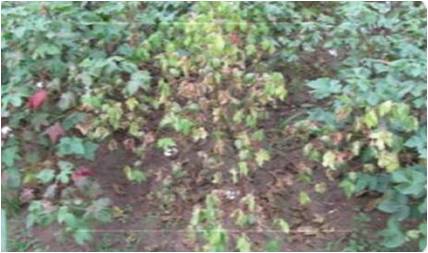Symptom
- Yellowing and browning of cotyledons followed by browning on the petiole.
- Loss of turgidity, yellowing, drooping and wilting of leaves.
- Browning or blackening of vascular tissues.
- Infected plants appear stunted with fewer bolls.
Survival and Mode of Spread
- Survive in soil as saprophyte for many years and chlamydospores act as resting spores.
- Primary spread is through seed, dormant hyphae and chlamydospores.
- The pathogen is externally and internally seed-borne.
- Secondary spread by wind and irrigation water.
Favourable Conditions
- Soil temperature of 20-30 0C .
- Hot and dry periods followed by rains .
- Heavy black soils with an alkaline reaction
- Increased dose of nitrogen and phosphatic fertilizers .
- Wounds caused by nematode (Meloidogyne incognita) and grubs of Ash weevil (Myllocerus pustulatus)
Management
- Remove and burn the infected plant debris in the soil after deep summer ploughing. .
- Apply farm yard manure or other organic manures @ 4 t/ac. .
- Follow mixed cropping with non-host plants to reduce the soil temperature below 200C by providing shade.
- Treat the acid-delinted seeds with Chlorothalonil at 4 g/kg of seed .
- Seed treatment with Bacillus subtilis (10g/kg) or Trichoderma asperellum @ 4 g/kg.
- Apply Trichoderma asperellum @ 1 kg/ acre, twice in the soil during sowing and 90 DAS . Multiply 1 kg of T. asperellum in 100 kg of Farm yard manure for 15 days before application.
- Spot drenching with Carbendazim 50%WP @1g/ lit of water
Source of information
- Online resources
- CPG 2020
|

|
Vascular browning |

|
Yellowing of leaves |
|


